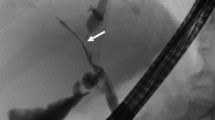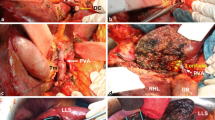Abstract.
Hilar resections and hemihepatectomies as surgical strategies for hilar cholangiocarcinoma achieve only limited rates of resectability and radicality. Principles of surgical oncology have to be applied in order to increase the numbers of patients undergoing resection as well as their long-term survival. Due to the anatomical architecture of the hepatic hilum and side-specific variations within the biliary tree, right trisectorectomy and principal portal vein resection have the potential to comply with basic rules of surgical oncology, i. e. wide tumor-free margins and a no-touch dissection technique. In our experience, 5-year survival after formally curative right trisectorectomy and portal vein resection is 65 % in spite of advanced tumor stages. Resection of the entire biliary tract without dissection of the tumor is possible by combining total hepatectomy, partial pancreatoduodenectomy and liver transplantation. However, even this procedure does still not fully prevent tumor cell dissemination. So far, a putative alteration of tumor cell kinetics due to posttransplant immunosuppressive treatment results in an increased rate of implantation metastases.
Zusammenfassung.
Hilusresektionen und Hemihepatektomien erreichen in der chirurgischen Therapie des häufigsten Leberhilustumors, dem zentralen Gallengangcarcinom, in der Regel unzureichende Raten von Resektabilität und Radikalität. Das angestrebte Ziel höherer Überlebensraten bei einer größeren Zahl von Patienten muss vor allem auch durch die Anwendung von Prinzipien der onkologischen Chirurgie erreicht werden. Aufgrund der anatomischen Lagebeziehungen im Leberhilus sowie asymmetrischer Verhältnisse des Gallengangbaumes können mit der Durchführung einer rechtsseitigen Trisektorektomie mit Pfortaderresektion de principe essentielle Grundzüge der onkologischen Chirurgie, wie weite tumorfreie Resektatränder und Vermeidung einer Dissektion tumorbefallener Areale am ehesten verwirklicht werden. Die 5-Jahresüberlebensrate nach formal kurativer Trisektorektomie mit Pfortaderresektion beträgt im eigenen Patientengut trotz fortgeschrittener Tumorstadien 65 %. Die vollständige Exstirpation des Gallengangbaumes ohne tumornahe Dissektion ist durch die en bloc-Hepatektomie mit partieller Pankreatoduodenektomie und Lebertransplantation möglich. Selbst dieses Verfahren kann eine Dissemination von Tumorzellen bislang nicht vollständig ausschließen. Das Hauptproblem besteht in einer offenbar veränderten Tumorzellkinetik unter Immunsuppression, die zu einer hohen Rate von Rezidiven und hier vor allem von Implantationsmetastasen führt.
Similar content being viewed by others
Author information
Authors and Affiliations
Rights and permissions
About this article
Cite this article
Jonas, S., Steinmüller, T. & Neuhaus, P. Chirurgische Therapie von Leberhilustumoren. Chirurg 72, 775–783 (2001). https://doi.org/10.1007/s001040170105
Issue Date:
DOI: https://doi.org/10.1007/s001040170105




